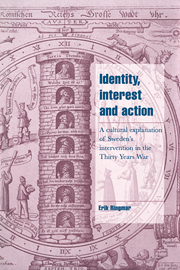 Identity, Interest and Action
Identity, Interest and Action Book contents
- Frontmatter
- Contents
- List of illustrations
- Acknowledgements
- Introduction: the beginning of the story
- Part I A narrative theory of action
- 1 Historical and scientific explanations
- 2 The modern orthodoxy
- 3 A narrative theory of action
- Part II Why did Sweden go to war in 1630?
- Conclusion: the end of the story?
- Notes
- Bibliography
- Index
1 - Historical and scientific explanations
Published online by Cambridge University Press: 21 October 2009
- Frontmatter
- Contents
- List of illustrations
- Acknowledgements
- Introduction: the beginning of the story
- Part I A narrative theory of action
- 1 Historical and scientific explanations
- 2 The modern orthodoxy
- 3 A narrative theory of action
- Part II Why did Sweden go to war in 1630?
- Conclusion: the end of the story?
- Notes
- Bibliography
- Index
Summary
Why did Sweden go to war in 1630?, we have asked, and before I proceed to give my own answer to this question we should investigate what previous scholars have said on the topic. Only once we know what has already been done in this field can we know what remains to be done, and only through a critique of previous approaches can a new approach be justified. There are two distinct bodies of scholarship which are relevant in this regard: the work of historians who specialise in Swedish, or European, seventeenth-century history, first of all, but also the work of social scientists who seek to formulate theories which address not this particular war, but war initiation in general. Let us begin with the historians.
The historiographical menu
If our aim is to find an explanation for an event such as an old war what we most probably do is to turn to a historian for help. Historians have a reputation for being thorough, modest and objective, and as long as we rely on them we would seem to be in good hands. Yet, and as we are about to see, this suggestion provides no easy solution to our query since the historians who have written on our case have given us not only one, but many different – and often radically diverging – explanations of why Sweden went to war.
- Type
- Chapter
- Information
- Identity, Interest and ActionA Cultural Explanation of Sweden's Intervention in the Thirty Years War, pp. 19 - 43Publisher: Cambridge University PressPrint publication year: 1996
